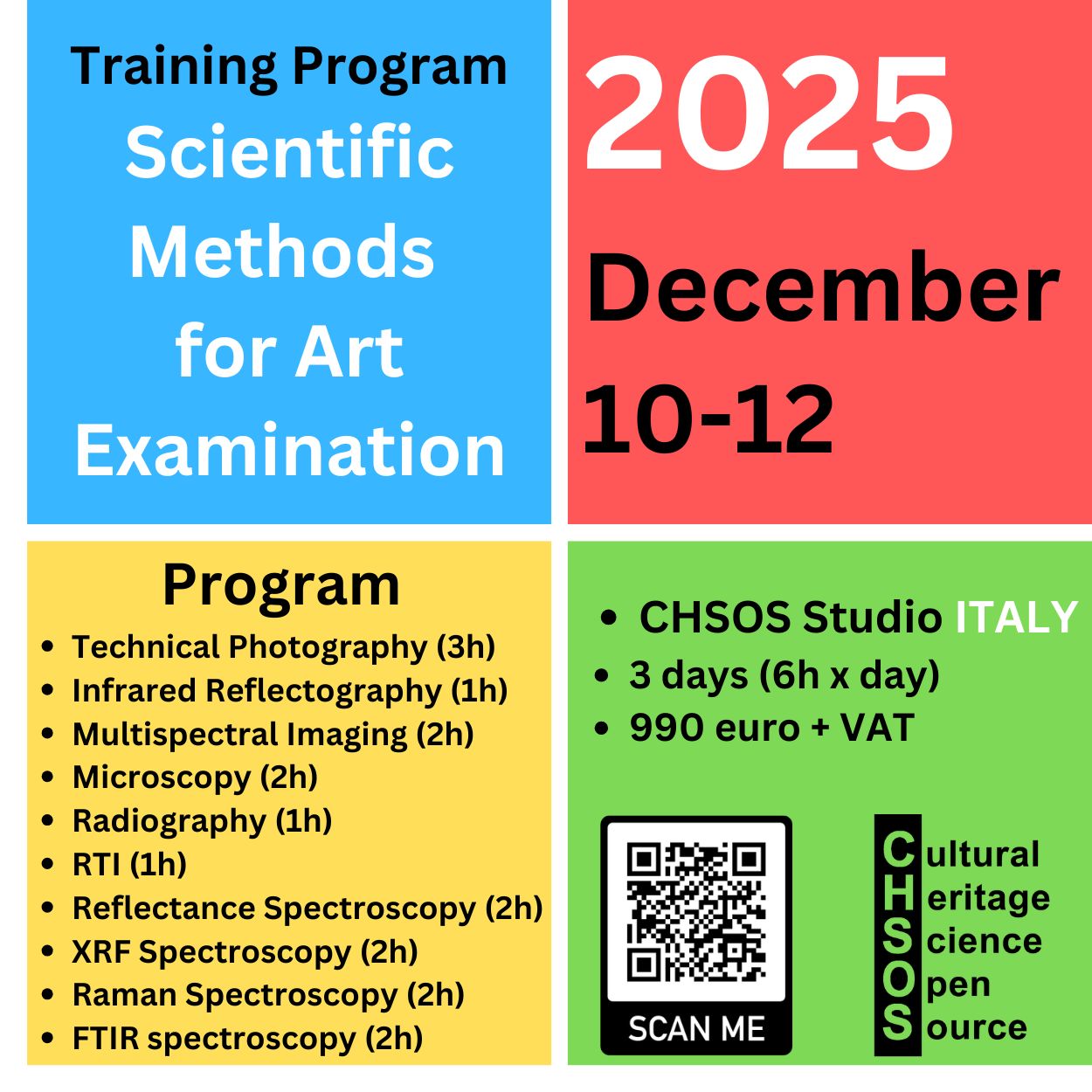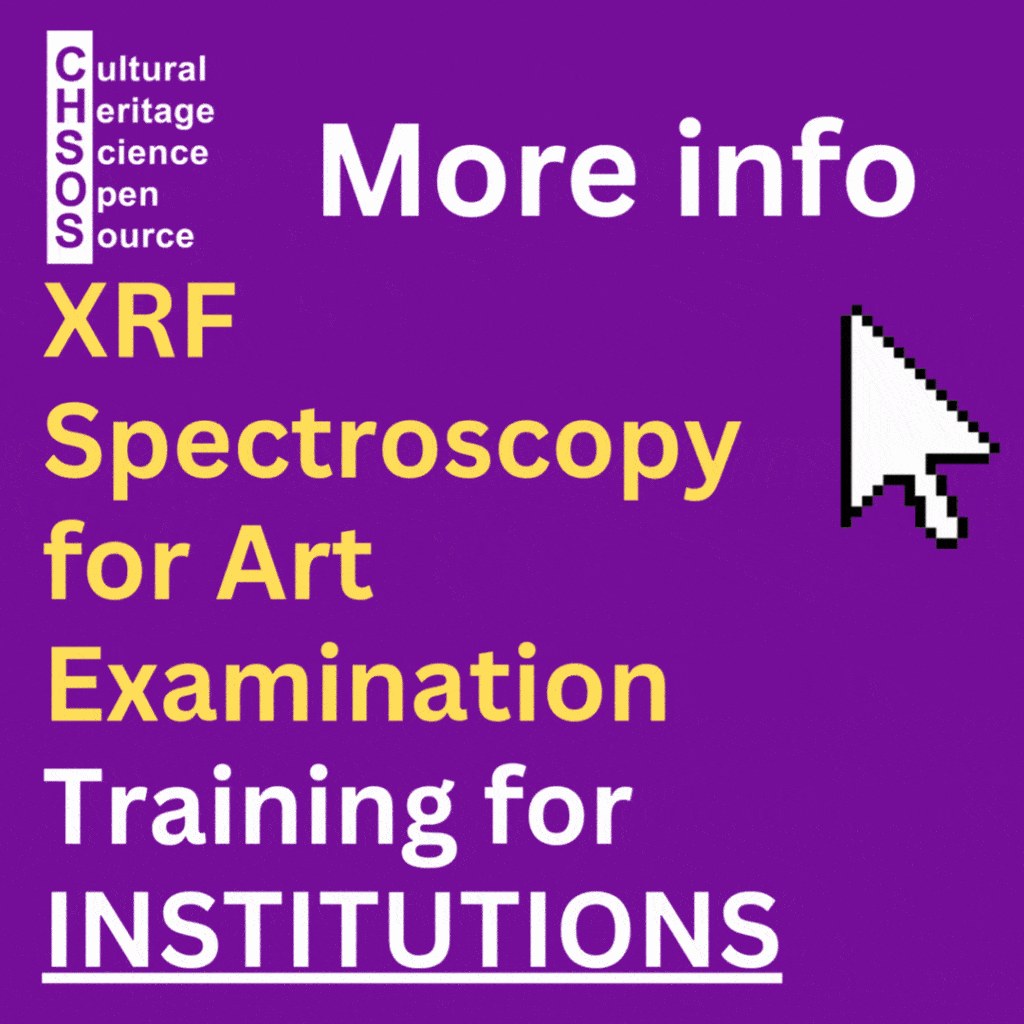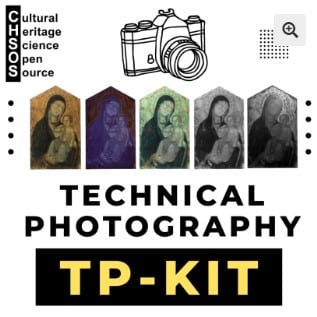Home » About » CHSOS Application Notes » CHSOS Application note #1: Testing GorgiasUV on Pigments Checker
Testing GorgiasUV on Pigments Checker
DOWNLOAD Application note #1: Testing GorgiasUV on Pigments Checker (576 downloads )

GorgiasUV is a new tool designed for reflectance spectroscopy in art examination.
Since 2021, the Reflectance Spectrometer GorgiasUV has joined our toolkit for scientific examination in art and archaeology.
Building on the standard Gorgias system, it is specifically optimized to cover a wider range into the UV, extending down to 200 nm.
As a result, GorgiasUV explores the extreme part of the UV spectrum with much greater reliability, providing valuable data for pigment identification.
Therefore, it is our recommended tool for Reflectance Spectroscopy Examination of Art.

Reflectance Spectroscopy for Art Examination
Used since the late 1980s [1], Reflectance Spectroscopy (RS) for Art Examination is a powerful tool for the identification of pigments and dyes [2]. In simple terms, a reflectance spectrum shows, for each wavelength, the ratio between the intensity of the reflected and incident radiation. This ratio is called reflectance and is given in percentage (%). To identify pigments, the unknown spectrum is compared against a spectral database by analyzing key spectral features.
Compared to other spectroscopic methods, RS offers several advantages: affordable equipment, small dimensions, and portability.
Gorgias UV system
Along with the usual halogen lamp, GorgiasUV features a Deuterium radiation source and a dedicated solarization-resistant fiber probe to effectively work within the UV range, figure [1].
We discuss the advantages of GorgiasUV over the standard Gorgias by testing the 2 instruments on the Pigments Checker, our collection of historical pigments, ranging from antiquity to the early 1950′. The colors are laid with an acrylic binder on a cardboard support. We collected the spectra of the pigments and that of the binder alone on the cardboard. All these spectra are available online on the Pigments Checker webpage.

Pigments Identification
For most pigments, there is no difference in using GorgiasUV or the standard Gorgias for Reflectance Spectroscopy of Art. This is because often the spectral information is in the visible and infrared regions.
This is the case for chrome oxide green. Figure [2] displays the spectra of this pigment acquired with Gorgias and GorgiasUV. We understand there is a maximum centered at 410 nm, in the visible region. This maximum is still clear and there is no uncertainty. The standard Gorgias covers the near UV region where the left shoulder of this maximum is found. The spectrum acquired with GorgiasUV does not add any other information. The same can be said for most of the other pigments.
Though, there are a few pigments where GorgiasUV provides extra information that make their identification more reliable.

Better maxima and absorption bands in the UV
GorgiasUV provides better spectra of maxima and absorption bands in the UV region. This is the case for viridian which has a maximum across the UV-VIS edge.
As chrome oxide green, this pigment is a chrome oxide but it also contains a water molecule. Figure [3] displays the spectrum of this pigment acquired with Gorgias and GorgiasUV. Gorgias shows that there is a maximum centered at 370 nm but we miss its shoulder in the UV region. On the other hand, the spectrum taken with GorgiasUV thoroughly captures this maximum. In the case of viridian, using GorgiasUV provides new information and a more satisfactory characterization of the pigment.
Other examples are carmine lake and alizarine which have a maximum across the UV-VIS region which becomes apparent in the GorgiasUV spectra, figure [4, 5].



Discovering new bands in the UV for better Pigments Identification
Some pigments have characterizing bands in the far UV which only GorgiasUV can discover. This is the case for some pigments, such as lead white, cobalt yellow, and ultramarine blue.
As a first example, we focus on the 6 white pigments in pigments checker: chalk, gypsum, lead white, zinc white, lithopone, and titanium white. Figure [6] and [7] show the spectra acquired, respectively, with the standard Gorgias and GorgiasUV. The standard Gorgias is already able to identify without ambiguity 3 white pigments: titanium white, zinc white and, lithopone. The other ones, chalk, gypsum, and lead white have similar flat and featureless spectra. We are not able to distinguish them using standard Gorgias.
Lead white
On the other hand, GorgiasUV reveals a characteristic absorption for lead white in the UV region. Chalk and gypsum have just flat spectra in the UV as well as in the visible and infrared region.
Figure [8] shows the spectra of just lead white acquired with the standard Gorgias and GorgiasUV. We can see the characterizing absorption band in the UV. The figure displays also the spectrum of the cardboard just painted with the same acrylic binder, so we are sure that the absorption band belongs just to lead white and not to the binder or cardboard.
Cobalt yellow and ultramarine blue
Figure [9] illustrates another example where GorgiasUV can make a difference for the identification of pigments. Cobalt yellow exhibits 2 further absorption bands in the UV region that we can’t record with the standard Gorgias.
The spectra of Ultramarine blue natural and artificial are represented in figure [10]. GorgiasUV reveals a characterizing curve in the UV region. There is also a study showing that is possible to distinguish, in some cases, natural ultramarine from the artificial one [3]. Testing the natural and artificial ultramarine in our Pigments Checker, we got similar results. The maximum appears shifted toward the UV for the artificial ultramarine.





Conclusions
Gorgias is surprisingly portable and a low-cost Reflectance Spectroscopy for Art Examination system. GorgiasUV provides better results in the UV range thanks to its Deuterium lamp, but because this special lamp is a bit bulkier. Also, it is more costly since it uses special fiber optics that must resist the UV radiation from the Deuterium lamp. We suggest the standard Gorgias for most applications and in particular for those that require mobility and travel with the equipment. GorgiasUV provides better results in the UV and we consider it a complementary tool to the standard Gorgias.
References
[1] BACCI, M., CAPPELLINI, V., CARLA’, R. (1987). Diffuse reflectance spectroscopy: An application to the analysis of art works, Journal of Photochemistry and Photobiology B: Biology, 1, Issue 1, 132.
[2] FONSECA, B., SCHMIDT PATTERSON, C., GANIO, M., MACLENNAN, D., & TRENTELMAN, K. (2019). Seeing red: towards an improved protocol for the identification of madder- and cochineal-based pigments by fiber optics reflectance spectroscopy (FORS). Heritage Science.
[3] ACETO, M., AGOSTINO, A., FENOGLIO, G., & PICOLLO, M. (2013). Non-invasive differentiation between natural and synthetic ultramarine blue pigments by means of 250–900 nm FORS analysis. Analytical Methods. 5, 4184.
Resources
CAMEO MFA – Fiber Optics Reflectance Spectroscopy (FORS)
A technical description of FORS with spectral references, examples of natural pigments, and real applications in art conservation.






